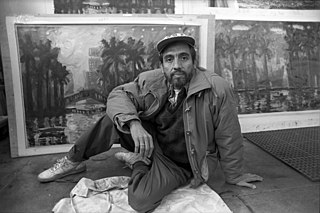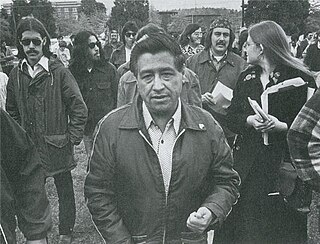
Chicano or Chicana is an ethnic identity for Mexican Americans who have a non-Anglo self-image, embracing their indigenous ancestry. Chicano was originally a classist and racist slur used toward low-income Mexicans that was reclaimed in the 1940s among youth who belonged to the Pachuco and Pachuca subculture. In the 1960s, Chicano was widely reclaimed in the building of a movement toward political empowerment, ethnic solidarity, and pride in being of indigenous descent. Chicano developed its own meaning separate from Mexican American identity. Youth in barrios rejected cultural assimilation into whiteness and embraced their own identity and worldview as a form of empowerment and resistance. The community forged an independent political and cultural movement, sometimes working alongside the Black power movement.

The Royal Chicano Air Force (RCAF) is a Sacramento, California-based art collective, founded in 1970 by Ricardo Favela, José Montoya and Esteban Villa. It was one of the "most important collective artist groups" in the Chicano art movement in California during the 1970s and the 1980s and continues to be influential into the 21st century.

Carlos D. Almaraz was a Mexican-American artist and a pioneer of the Chicano art movement. He was one of the founder of the Centro de Arte Público (1977–1979), a Chicano/Chicana arts organization in Highland Park, Los Angeles.

The Chicano Movement, also referred to as El Movimiento, was a social and political movement in the United States that worked to embrace a Chicano/a identity and worldview that combated structural racism, encouraged cultural revitalization, and achieved community empowerment by rejecting assimilation. Chicanos also expressed solidarity and defined their culture through the development of Chicano art during El Movimiento, and stood firm in preserving their religion.

The Centro Cultural de la Raza is a non-profit organization with the specific mission to create, preserve, promote and educate about Chicano, Mexicano, Native American and Latino art and culture. It is located in Balboa Park in San Diego, California.The cultural center supports and encourages the creative expression “of the indigenous cultures of the Americas.” It is currently a member of the American Alliance of Museums.
Gilbert "Magu" Luján was a well known and influential Chicano sculptor, muralist and painter. He founded the famous Chicano collective Los Four that consisted of artists Carlos Almaraz, Beto de la Rocha, Frank Romero and himself. In 1974, Judithe Hernández became the "fifth" and only female member of Los Four.

Galería de la Raza (GDLR) is a non-profit art gallery and artist collective founded in 1970, that serves the largely Chicano and Latino population of San Francisco's Mission District. GDLR mounts exhibitions, hosts poetry readings, workshops, and celebrations, sells works of art, and sponsors youth and artist-in-residence programs. Exhibitions at the Galería tend to feature the work of minority and developing country artists and concern issues of ethnic history, identity, and social justice.
César Augusto Martínez is an artist, prominent in the field of Chicano art. While studying at what was then called Texas A&I College, he became involved in the Chicano movement for civil rights. He subsequently befriended several of its leaders.

Alma López is a Mexican-born Queer Chicana artist. Her art often portrays historical and cultural Mexican figures, such as the Virgin of Guadalupe and La Llorona, filtered through a radical Chicana feminist lesbian lens. Her art work is meant to empower women and indigenous Mexicans by the reappropriation of symbols of Mexica history when women played a more prominent role. The medium of digital art allows her to mix different elements from Catholicism and juxtapose it to indigenous art, women, and issues such as rape, gender violence, sexual marginalization and racism. This juxtaposition allows her to explore the representation of women and indigenous Mexicans and their histories that have been lost or fragmented since colonization. Her work is often seen as controversial. Currently, she is a lecturer at the University of California Los Angeles in the Department of Chicana/o Studies.

The Chicano Art Movement represents groundbreaking movements by Mexican-American artists to establish a unique artistic identity in the United States. Much of the art and the artists creating Chicano Art were heavily influenced by Chicano Movement which began in the 1960s.
Patssi Valdez is an American Chicana artist. She is a founding member of the art collective Asco. Valdez's work represents some of the finest Chicana avant-garde expressionism which includes but not limited to painting, sculpture and fashion design. She lives and works in Los Angeles, California.
Willie Herrón III is an American Chicano muralist, performance artist and commercial artist.
Rita Sanchez is an American academic in the field of Chicana/o studies.
Yreina Cervantez is an American artist and Chicana activist who is known for her multimedia painting, murals, and printmaking. She has exhibited nationally and internationally, and her work is in the permanent collections of the Smithsonian American Art Museum, The Mexican Museum, the Los Angeles County Museum, and the Los Angeles Museum of Contemporary Art.
Melesio "Mel" Casas was an American artist, activist, writer and teacher who is best known for his paintings that address Chicano topics. He used visual statements, his sense of humor and love of puns to "address cultural stereotypes." His work has been collected by the San Antonio Museum of Art, Smithsonian American Art Museum, Museum of Fine Arts, Houston, Crystal Bridges Museum of American Art, as well as national and international private collectors. His most important series consists of 150+ large-scale paintings called "Humanscapes" that were painted between 1965 and 1989. Casas, who served as president of the Con Safo art group, was also well known as a writer and theorist. His "Brown Paper Report" is regarded as an important Chicano document. Casas emphasized the importance of "self-determination" and equality for Chicanos/as. He is regarded as one of the foundational figures of Chicano Art. Casas felt that once artists had a fair chance to exhibit in the United States, then they would become part of "Americana."

Rafael Esparza is an American performance artist who lives and works in Los Angeles. His work includes performances affecting his physical well-being and installations constructed from adobe bricks. Esparza often works with collaborators, including members of his family.
Delilah Montoya is a contemporary artist and educator who was born in Fort Worth, Texas and was raised in Omaha, Nebraska by her Anglo-American father and Latina mother. She earned her BA, MA and MFA from the University of New Mexico. Her art is noted for its exploration of Chicana identity and for innovative printmaking and photographic processes. She is also noted for her use of mixed-media installations and often incorporates iconic religious symbols in her pieces. Montoya divides her time between Albuquerque and Houston. She taught at the University of New Mexico, Institute of American Indian Arts and California State University before accepting her current position at the University of Houston. She was a 2008 Artadia awardee.

The Cheech Marin Center for Chicano Art, Culture & Industry of the Riverside Art Museum, or The Cheech, is an art museum and academic center in Riverside, California, United States. The center is focused on the presentation and study of chicano art from across the United States. It is a collaborative effort between stand-up comedian, actor, and writer Cheech Marin, who has donated his collection of more than 700 pieces of Chicano art, the City of Riverside, which provided the facilities to house the collection, and the Riverside Art Museum, which manages the center. The collection is housed in the old Riverside public library, and strives to be a world-class institution for the research and study of "all things [related to] Chicano art". It is the first North American facility dedicated to Mexican-American art.
Elizabeth Sisco is an artist active in the Chicano art movement.
Margaret Garcia is a Chicana muralist, educator, and arts-advocate based in Los Angeles.










